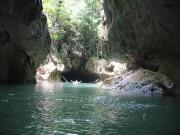|
Cave paintings were a way to communicate and mark territory in ancent
times. Most cave paintings were created during the Upper Palaeolithic period which was from 40,000 to 10,000 BC. Many of these
paintings were created by Magdalenians. This art work was known to be the first in time. It was also considered to be the
longest lasting art in history. The first work of art found in a cave was discovered only in the late 1800's. It was not until
1902 that anthropologists and art historians considered this ancient art. Thrughtout the 1900's there were 277 cave paintings
found in Europe, 142 in France, 108 in Spain, 21 in Italy, 2 in Portugal, 2 in Germany and 2 in the Balkans. Most of
the paintings however, were extremely elegable and fragile. When a cave is 'opened' it makes it very hard for the paintngs
to stay restored. Therefore finders must be very careful and precise. One of the most famous cave painting was found
at Bedeilhac in the Pyrenees during the First World War but disappeared completely within six months of the cave's discovery.
Due to the change in climate, location and human handeling. After many artifacts have been distroyed, caves have now been
closed to the public and is a very serious manner when it comes to opening them. One of the greatest, largest, most infamous
caves only has a small portion open at certain times. This cave is the Altamira Cave located in Spain. One of the paintings
of a bison located in the Altamira cave:

Many of the paintings located in the caves represent human
hands, large numbers of animals, including some extinct species, like the woolly rhinoceros, which have been extinct
for a period of time now. Paintings of humans are extremly rare, which in a way indicates the importance animals had throughout
ancient times. The earliest of the paintings were engraved in clay by fingers. Another way historians have reconized were paintings
engraved by flakes of sharp flint or stone picks. The Magdelanians used different rock types to form color and shades.
Most of the paintings are located on the ceilings of caves. Discoveres find themslves laying on the floor to capture pictures.
The drawings that were engraved on the floor are extremly rare, due to feet, animals or erosion of the caves. One of
the first colors used to create these paintings were were red, iron oxide, a form of red ochre and black manganese dioxide
Black from juniper has also been found. White from kaolin was used in rare paintings. The only other color available
to Magdalenian painters were yellow and brown, simply from rocks and stones. The Magdeanians used shells oe hollow rocks for
storage of the colors while painting. Bird bones were sometimes used as brushes to apply the paint. These paintings are so
interesting mainly due to the way they were completed. It is so simple today to use paint and paint brushes, but people of
ancient times had such complexity to deal with.
Cave paitings were not done in any caves that people lived in but
caves that they new the art would survive in. Some infamous caves that had pantings found were Labastide in the Pyrenees,
where the longest painting was found and it was of a horse, Bernifal in the Dordogne, which had a 20 feet high mammoth, the
notorious bulls at Lascaux and finally the painting of the extinct woolly rhinoceros at Font de Gaume. There are different
hints in the paintings that let us know the importance of animals to these ancient people. In the scenes with human hands
and animals, the animlas were portrayed as larger and more dominant. The shading done on the animals legs let us to believe
there elegence, and the amount of bold colors let us know their necessity to human kind.

Although there are very few caves that people can still visit, some
of the most valuble cave paintings are located in art museums. The caves that people visit are not the same caves that consisted
of the valuble paintings. The caves people visit today are smaller caves that are usually in rainforests or jungles. The caves
usually have water through them. The caves that ancient people painted in were large caves that rarely
had human contact. The ancient Magdalenian way of like seemed near impossible to explain and requires
an effort of imagination which may be beyond us. but it's hints like cave paintings that give us a small outlook on what happened
during ancient times.
 an actual cave I went tubbing through in Belize. an actual cave I went tubbing through in Belize.
sources-
|

